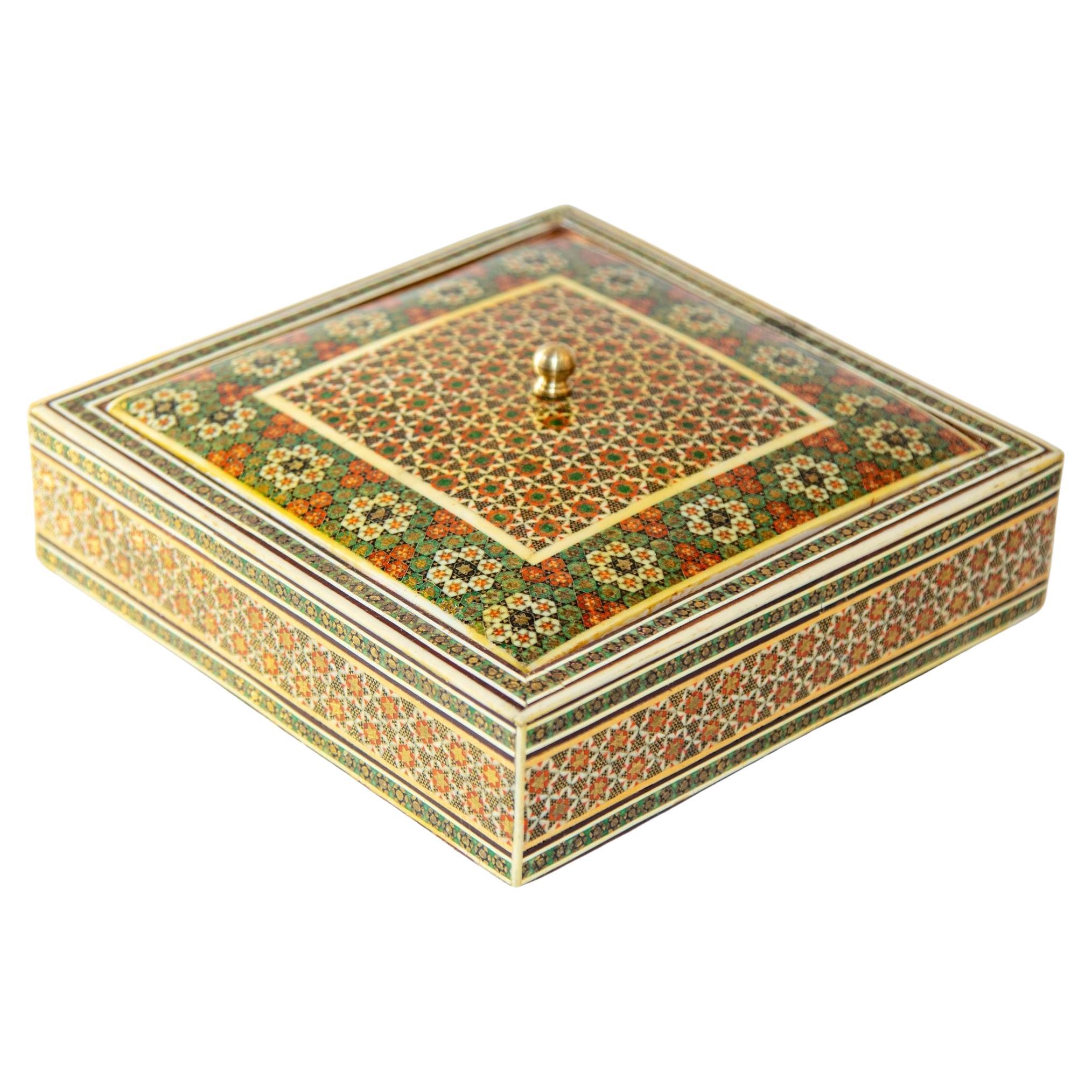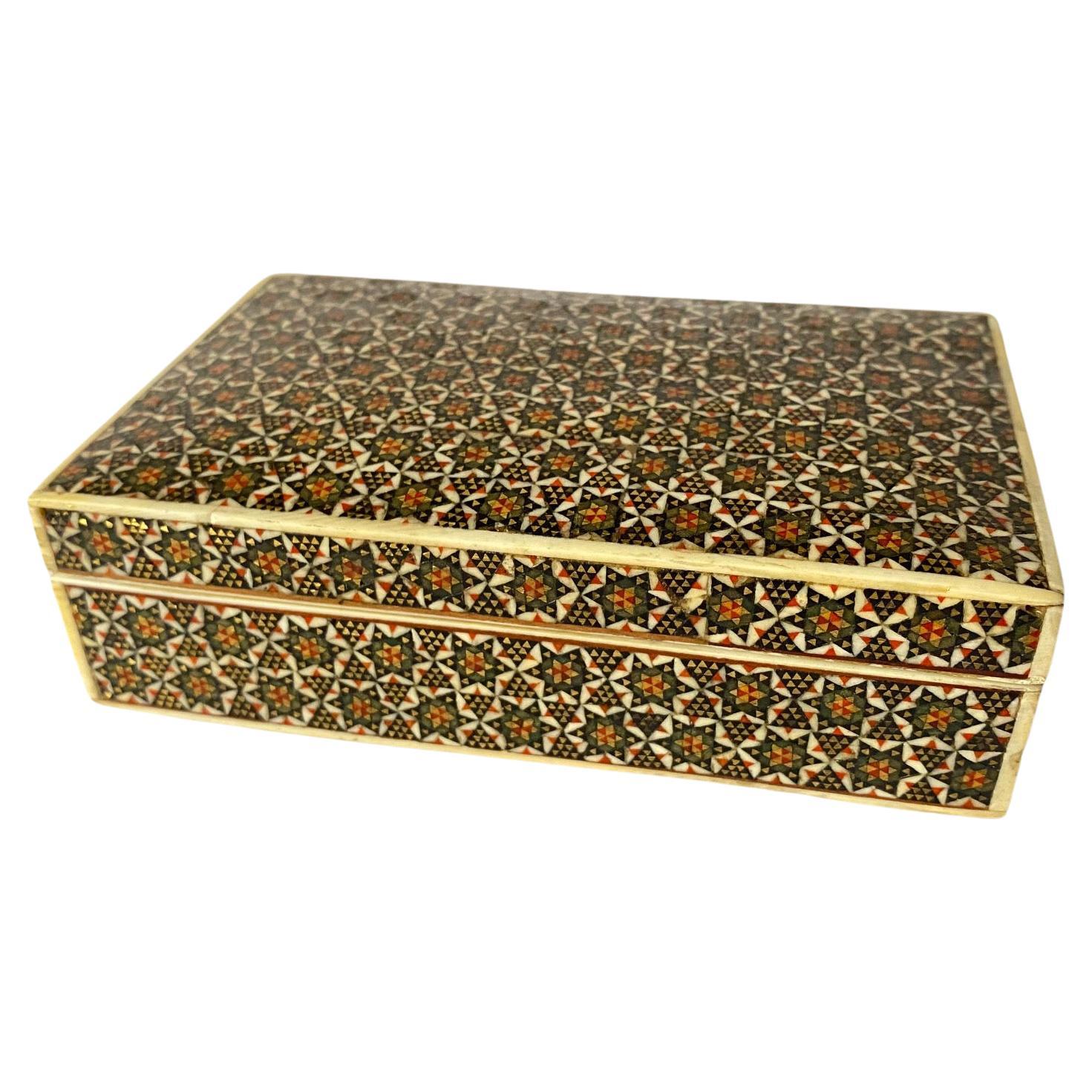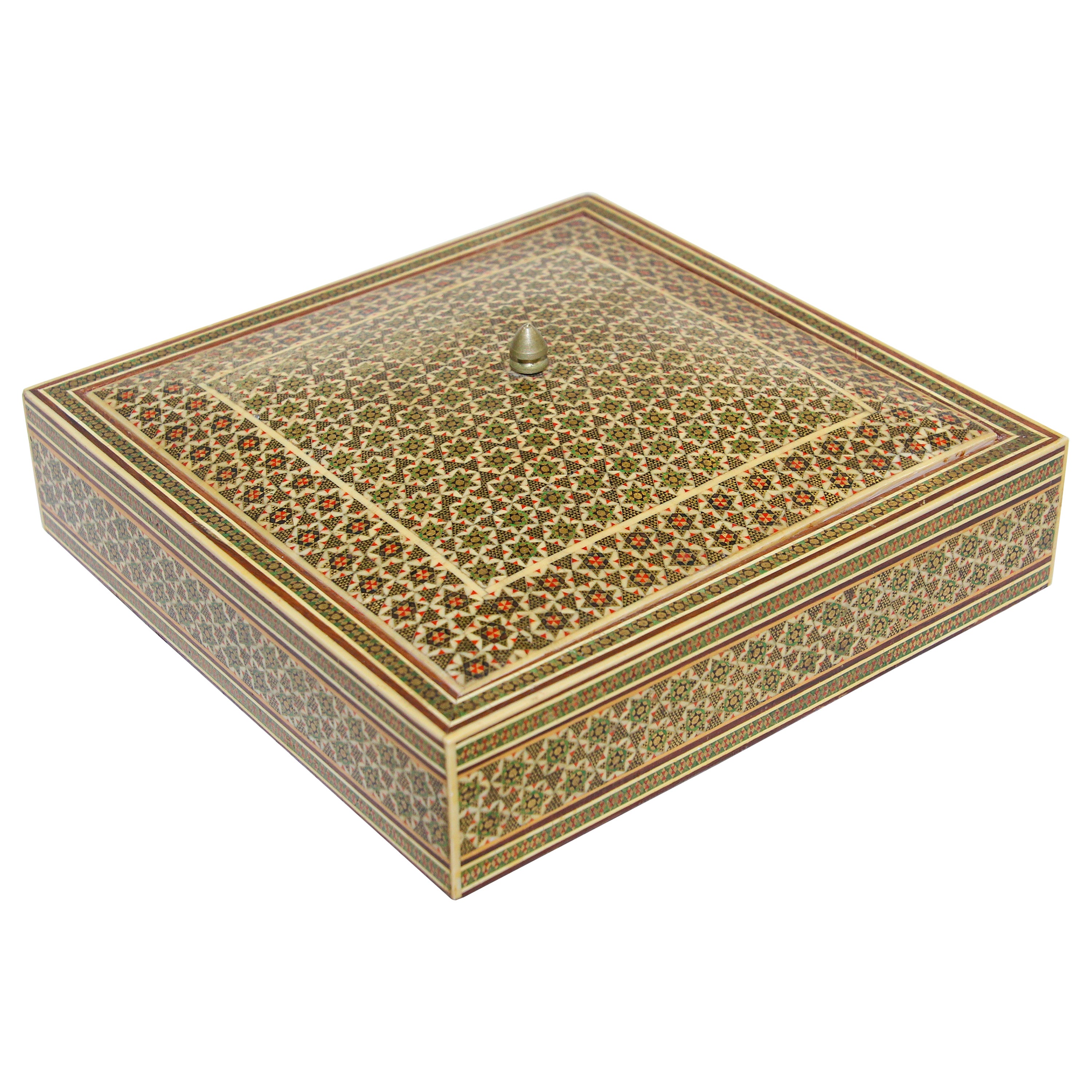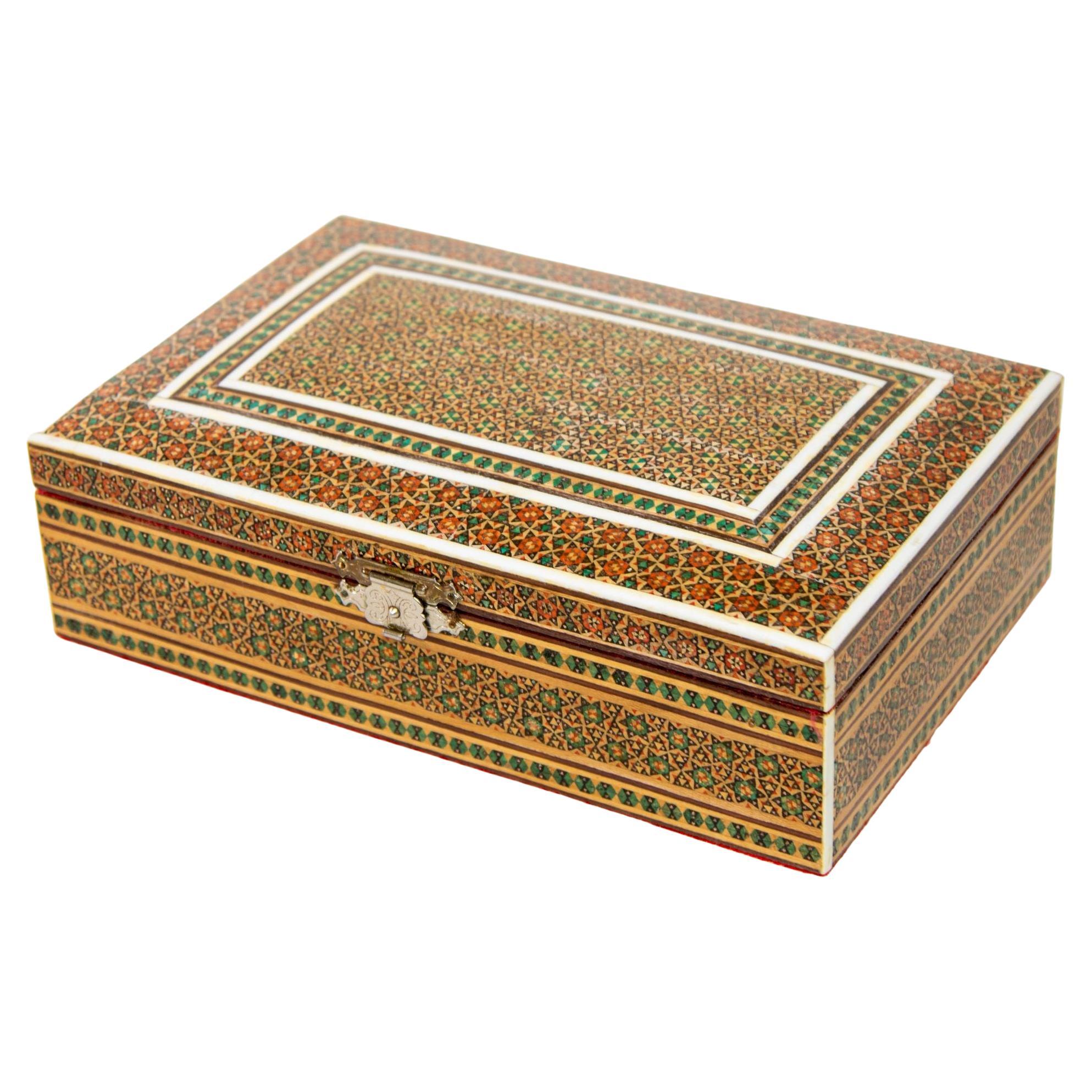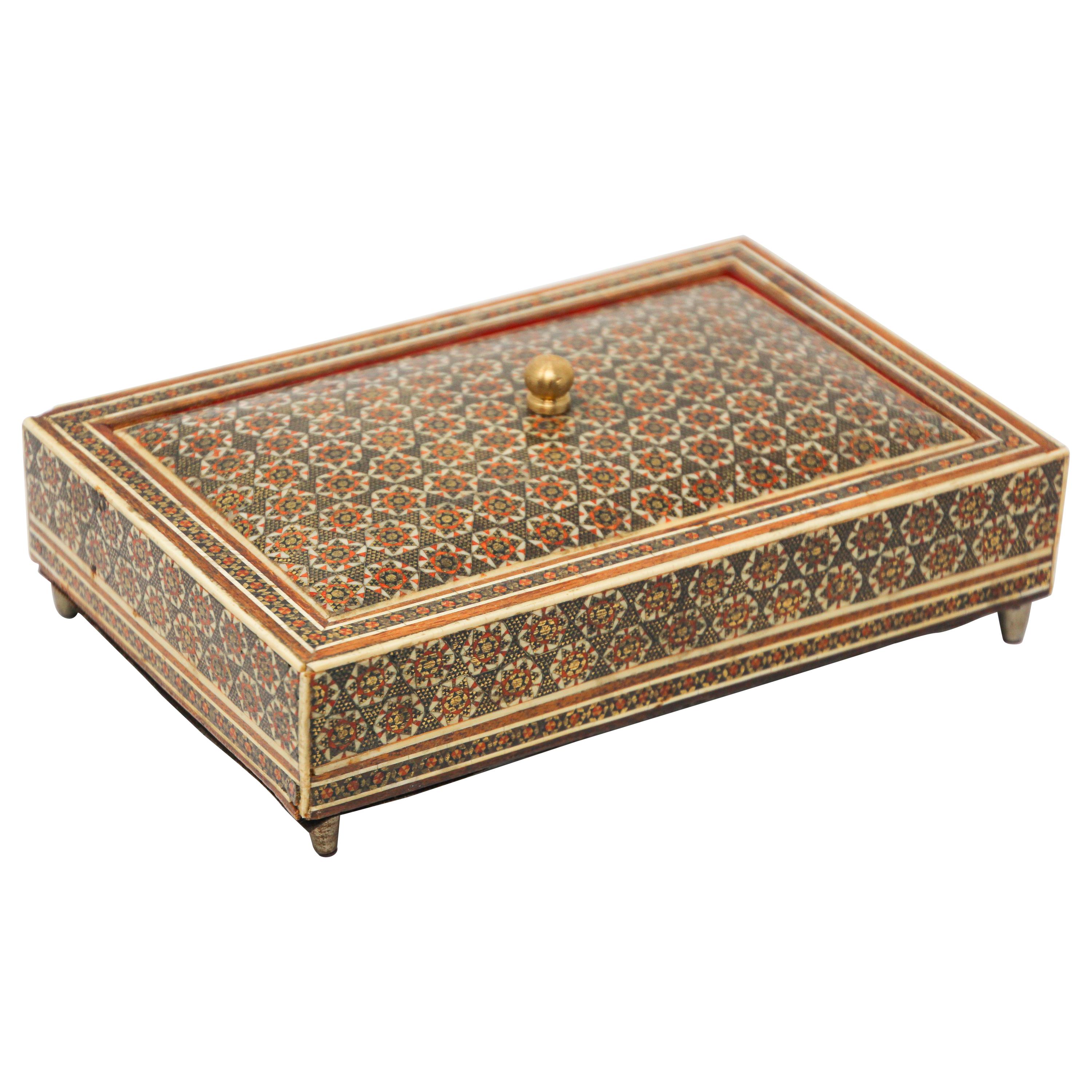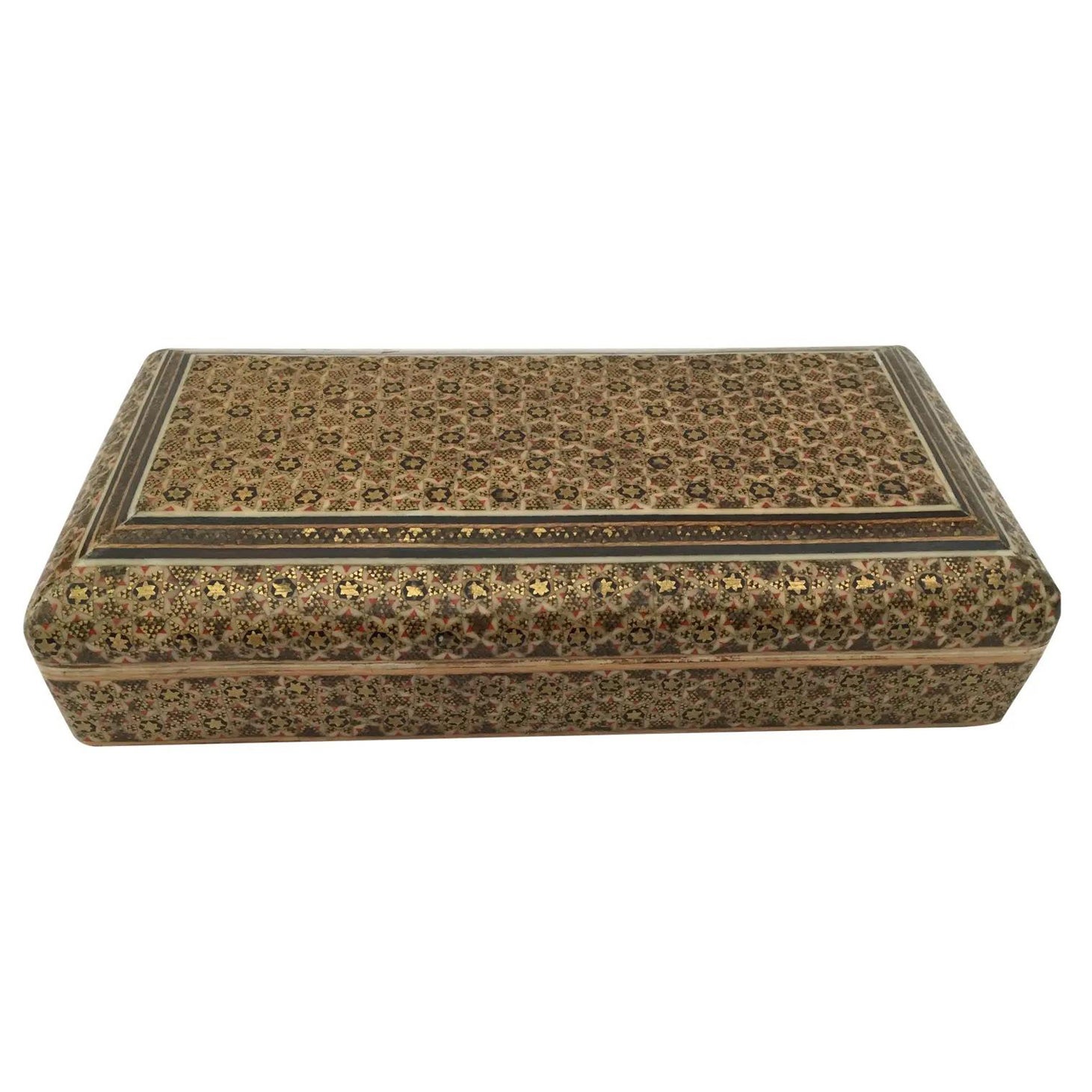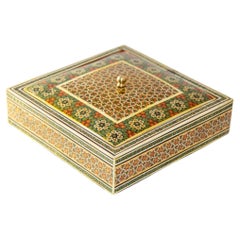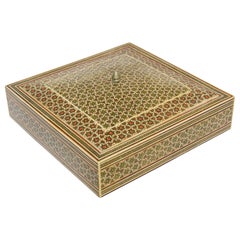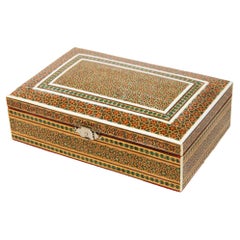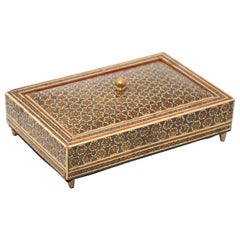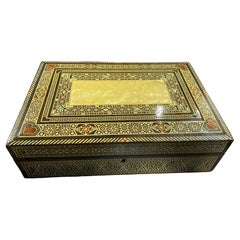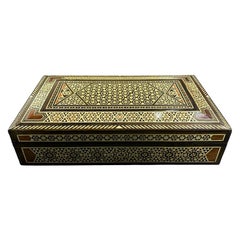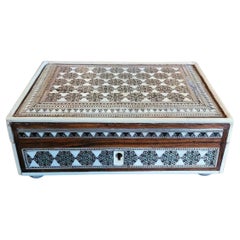Items Similar to 1950s Anglo Indian Style Micro Mosaic Inlaid Jewelry Box
Video Loading
Want more images or videos?
Request additional images or videos from the seller
1 of 22
1950s Anglo Indian Style Micro Mosaic Inlaid Jewelry Box
$650
£493.13
€565.40
CA$925.96
A$1,004.90
CHF 528.73
MX$12,209.54
NOK 6,619.66
SEK 6,233.01
DKK 4,221.60
About the Item
1950's Anglo Indian, Indo Persian style micro mosaic inlaid jewelry box with lid.
Large vintage intricate inlaid middle Eastern Persian style box with floral and geometric Islamic Moorish design in a rectangular form.
Moorish design bone inlay and marquetry, very fine artwork, lined in red velvet.
Museum collector piece like the one in Doris Duke Islamic Art Museum.
Moorish Persian style micro mosaic marquetry inlaid jewelry box with lid in this intricate inlaid Anglo Indian box with floral and geometric Islamic Moorish mosaic Sadeli design in a square shape form with mosaic inlay and marquetry, very fine artwork, lined in red velvet.
The repeating geometric patterns of Sadeli Mosaic are what give it beauty and richness.
This decorative technique is a type of micro mosaic featuring repeating geometric patterns.
A highly skilled craft, it has had a long history in India and the Middle East with early examples dating back to the 16th century. In the 1800s, it became popular as a decoration on a variety of boxes, card cases, and chess boards imported from India. Since Bombay became a center of making them, they became known as Bombay boxes.
The ancient art of Sadeli Mosaic is said to have been introduced from Shiraz in Persia via Sind to Bombay, a long time before Indian boxes appeared. The designs on early boxes look deceptively simple. The fact is they emerged from a culture which had mastered geometry and understood how to generate a pattern from a set number of points.
The patterns are so harmoniously combined that their incredible complexity isn’t immediately apparent to the viewer.
Made in India for the British and European market.
- Dimensions:Height: 4 in (10.16 cm)Width: 9 in (22.86 cm)Depth: 9 in (22.86 cm)
- Style:Anglo-Indian (In the Style Of)
- Materials and Techniques:
- Place of Origin:
- Period:
- Date of Manufacture:1950
- Condition:
- Seller Location:Moreno Valley, CA
- Reference Number:Seller: BP7231stDibs: LU906835152012
About the Seller
5.0
Platinum Seller
Premium sellers with a 4.7+ rating and 24-hour response times
1stDibs seller since 2011
3,139 sales on 1stDibs
Typical response time: <1 hour
- ShippingRetrieving quote...Shipping from: Moreno Valley, CA
- Return Policy
Authenticity Guarantee
In the unlikely event there’s an issue with an item’s authenticity, contact us within 1 year for a full refund. DetailsMoney-Back Guarantee
If your item is not as described, is damaged in transit, or does not arrive, contact us within 7 days for a full refund. Details24-Hour Cancellation
You have a 24-hour grace period in which to reconsider your purchase, with no questions asked.Vetted Professional Sellers
Our world-class sellers must adhere to strict standards for service and quality, maintaining the integrity of our listings.Price-Match Guarantee
If you find that a seller listed the same item for a lower price elsewhere, we’ll match it.Trusted Global Delivery
Our best-in-class carrier network provides specialized shipping options worldwide, including custom delivery.More From This Seller
View All1950s Anglo Indian Micro Sadeli Mosaic Inlaid Jewelry Box
Located in Moreno Valley, CA
1950s Anglo Indian Micro Sadeli Mosaic Inlaid Jewelry Box.
DIMENSIONS: 7ʺW × 7ʺD × 2.5ʺH.
Indo Persian Moorish style micro mosaic inlaid jewelry box with lid.
Intricate inlaid Anglo ...
Category
Mid-20th Century Indian Moorish Decorative Boxes
Materials
Bone, Fruitwood
Moorish Micro Mosaic Inlaid Jewelry Box
By Rajhastani
Located in Moreno Valley, CA
Moorish style micro mosaic marquetry inlaid jewelry box with lid.
Intricate inlaid Anglo Indian box with floral and geometric Islamic
Moorish mosaic Sadeli design in a square shape form with mosaic inlay and marquetry, very fine artwork, lined in red velvet.
Museum collector piece like the one in Doris Duke Islamic Art Museum.
The repeating geometric patterns of Sadeli Mosaic are what give it beauty and richness. This decorative technique is a type of micro mosaic featuring repeating geometric patterns. A highly skilled craft, it has had a long history in India and the Middle East with early examples dating back to the 16th century. In the 1800s, it became popular as a decoration on a variety of boxes, card cases, and chess boards imported from India. Since Bombay became a center of making them, they became known as Bombay boxes...
Category
Mid-20th Century Indian Agra Jewelry Boxes
Materials
Wood
Middle Eastern Persian Micro Mosaic Khatam Inlaid Jewelry Box
Located in Moreno Valley, CA
Large Middle Eastern Indo-Persian Micro Mosaic Khatam Inlaid Wooden Jewelry Box.
Middle Eastern Persian Sadeli micro mosaic marquetry inlaid box with geometric Moorish design.
Handcrafted Khatam wooden box with very delicate micro mosaic marquetry from the ancient Middle Eastern technique of inlaying from arrangements of so many delicate pieces of precious hand painted wood, with bone around the edges.
This beautiful Middle Eastern Persian, Indian Wooden box is covered with fine Moorish micro mosaic marquetry and is used as a jewelry, trinket box.
Lined in deep red velvet.
Dimensions: 6.5in.D x 3in.H x 10 wide.
Nice Indian Mughal, Indo Persian Box...
Category
Mid-20th Century Indian Moorish Jewelry Boxes
Materials
Fruitwood
Moorish Decorative Sadeli Micro Mosaic Inlaid Jewelry Box
Located in Moreno Valley, CA
Middle Eastern Sadeli micro mosaic inlaid jewelry footed box with lid.
Intricate inlaid box with floral and geometric Moorish design.
Sadeli micro mosaic designs in mosaic marquetry, very fine artwork.
Lined with red velvet and glass, top final and feet are brass.
A highly collectible example in superb condition complete
Circa 1900.
Museum piece like the ones in Doris Duke Islamic Art Museum.
Middle Eastern Arabian Micro Mosaic Moorish...
Category
Early 20th Century Lebanese Moorish Decorative Boxes
Materials
Fruitwood
Indo-Persian Khatam Micro Mosaic Jewelry Box
Located in Moreno Valley, CA
Handcrafted Khatam wooden box with very delicate micro mosaic marquetry from the ancient Persian technique of inlaying from arrangements of so many delicate pieces of wood, precious wood, and delicate miniatures paintings.
This beautiful Middle Eastern Persian style box is covered inside and out with fine Moorish micro mosaic marquetry.
Indo Persian Moorish style micro mosaic inlaid jewelry box with lid.
Intricate inlaid Asian Indian box with floral and geometric Islamic
Moorish Sadeli design in a square shape form with inlay marquetry, very fine artwork, lined in red velvet.
Museum collector piece like the one in Doris Duke Islamic Art Museum.
The repeating geometric patterns of Sadeli Mosaic are what give it beauty and richness. This decorative technique is a type of micro mosaic featuring repeating geometric patterns. A highly skilled craft, it has had a long history in India and the Middle East with early examples dating back to the 16th century. In the 1800s, it became popular as a decoration on a variety of boxes, card cases, and chess boards imported from India. Since Bombay became a center of making them, they became known as Bombay boxes...
Category
Mid-20th Century Asian Moorish Decorative Boxes
Materials
Wood
Anglo Indian Micro Sadeli Mosaic Inlaid Hexagonal Box
Located in Moreno Valley, CA
Anglo Indian Moorish style micro mosaic inlaid jewelry box with lid.
Intricate inlaid Anglo Indian box with floral and geometric Moorish Sadeli design in an octagonal shape form with micro mosaic marquetry, very fine artwork.
Museum collector piece like the one in Doris Duke Islamic Art Museum.
The repeating geometric patterns of Sadeli Mosaic...
Category
Early 20th Century Moorish Jewelry Boxes
Materials
Fruitwood
You May Also Like
Anglo Indian Micro Mosaic Inlay Jewelry Box
Located in New York, NY
Exquisitely crafted early 20th century Anglo Indian micro mosaic Sadeli box with gorgeous antique Persian geometric pattern.
The finely detailed box featu...
Category
Early 20th Century Indian Anglo-Indian Jewelry Boxes
Materials
Bone, Fruitwood
Moroccan Moorish Middle Eastern Large Inlaid Wood Micro Mosaic Jewelry Box
Located in Studio City, CA
Stunning mosaic design, this intricate quite large wood jewelry box is made from multiple micro pieces of wood, mother of pearl with some possib...
Category
20th Century Moorish Jewelry Boxes
Materials
Wood
Moroccan Moorish Middle Eastern Large Inlaid Wood Micro Mosaic Jewelry Box
Located in Studio City, CA
Stunning mosaic design, this intricate wood box is made from multiple micro pieces of wood with some possible bone inlays. Gorgeous craftsmanship. A true work of art.
Would be a g...
Category
20th Century Moorish Jewelry Boxes
Materials
Wood
19C Anglo Indian Bombay MOP Sadeli Mosaic Trinket Box
Located in Dallas, TX
PRESENTING a LOVELY 19C Anglo Indian Bombay MOP (Mother of Pearl) Sadeli Mosaic Trinket Box from circa 1875-85.
Gorgeously detailed and hand-crafted ‘sadeli mosaic’ inlay, from the Bombay Area, with deep greens with silver, pewter, mother of pearl, bone and ebony in geometric patterns.
The box case, is made of sandalwood but completely covered in MOP, bone, faux ivory, ebony and mosaic inlay.
Edged with faux ivory and banded with a different pattern of sadeli mosaic.
Some minor damage to the top (repair is obvious in pics) and ivorine replacements to some edging, but it still a BEAUTIFUL BOX and of real QUALITY!
The mosaic work is FABULOUS!
Box opens to reveal its original blue velvet lining.
It sits on 4 (recently added) silvered button feet.
SADELI MOSAIC: “Anglo Indian boxes were made in India for the English residents from the early part of the 18th century. They were brought back or sent back to England usually by the people who had commissioned them. From the beginning of the nineteenth century they were imported more commercially, although not in any significant numbers until the middle decades. They were very highly valued, especially the early ones, to the extent that the designs were copied on late 19th and early 20th century tins.
The ancient art of Sadeli Mosaic is said to have been introduced from Shiraz in Persia via Sind to Bombay, a long time before the Anglo Indian boxes were made. It was a technique, which required a high degree of skill and patience. It was executed very lavishly, in that the frequent cuts wasted a great amount of the precious materials used. The workmanship was however more than commensurable to the value of the materials.
Ivory, silver, pewter (or other metals), wood and horn were cut into faceted rods which were bound together to form geometric patterns. When the glue has set, the rods were sliced in transverse sections. This gave the maker a number of angled circular pieces in the original pattern. Several variations of patterns could be achieved by combining the materials in different ways. The ivory was sometimes dyed green to give an extra color.
The mosaic pieces in a combination of patterns, often separated by ivory, ebony, horn or silver stringing were used to veneer sandalwood boxes. In the early boxes, which date from the turn of the 18th to the 19th century, there are large panels of mosaic covering tops and sides of boxes. It took incredible skill to cover such large areas without any shakes or wavering of the pattern. The corners and joins on these boxes are impeccably matched.
The makers (reputed to be Persian) of Sadeli mosaic made in the first two decades of the 19th century displayed a total understanding of the qualities of the different materials they used. They combined substances, which can expand and contract according to atmospheric conditions with others, which are hard and unyielding. The result was a sharp definition of the lines and patterns, which made up the whole design.
On the early boxes the designs look deceptively simple. The fact is, they emerged from a culture, which had mastered geometry and understood how to generate a pattern from a set number of points. The patterns are so harmoniously combined that their incredible complexity is not immediately apparent.
The earliest Sadeli boxes...
Category
Antique Late 19th Century Indian Anglo-Indian Jewelry Boxes
Materials
Silver
Moorish Inlaid Marquetry Mosaic Jewelry Box with Geometric and Floral Patterns
Located in Bad Säckingen, DE
This is a Moorish-style jewelry box adorned with inlaid marquetry work, featuring a mosaic of geometric and floral patterns. The design is highly detailed, with small pieces of wood,...
Category
Vintage 1940s Moroccan Moorish Jewelry Boxes
Materials
Wood, Mother-of-Pearl, Fruitwood
19th Century Anglo Indian Inlaid Mosaic Box With Drop Front and Drawers
Located in Stamford, CT
19th Century Anglo Indian fall front box with six drawers with metal pulls. The exterior and interior inlaid throughout with bone and various woods. Intricate geometric designs cover...
Category
Antique Mid-19th Century Decorative Boxes
Materials
Bone, Fruitwood, Holly
More Ways To Browse
Large Vintage Jewellery Box Jewellery Boxes
Indian Jewellery
Micro Mosaic
Anglo Indian Jewelry
Indian Inlay
Indian Inlay Furniture
Anglo Indian Inlay
Inlaid Indian Furniture
Vintage Mosaic Jewelry
Ancient Mosaic
Middle Eastern Box
Micro Mosaic Box
Mosaic Inlaid Box
Bombay Box
Middle Eastern Mosaic Inlaid Jewelry Box
Persian Inlaid
Indian Marquetry
Persian Jewelry Box
